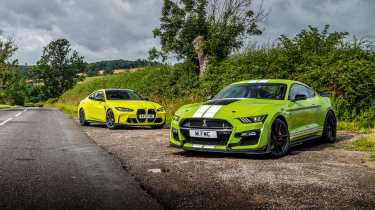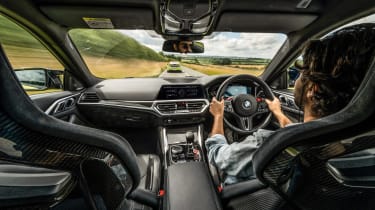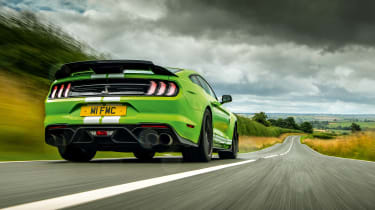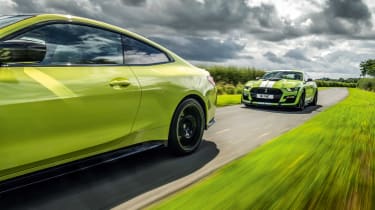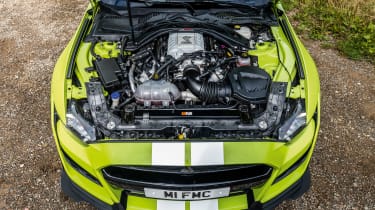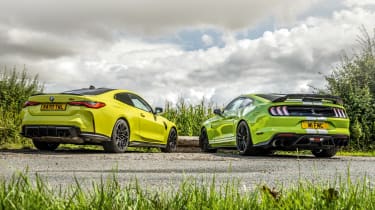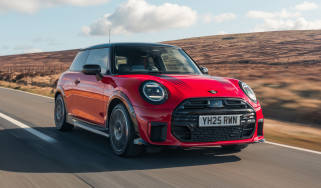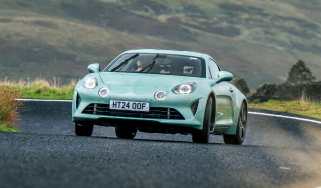BMW M4 Competition v Ford Mustang Shelby GT500
With 760bhp, the latest Shelby GT500 is Ford’s fruitiest Mustang ever, and it’s got chassis chops to match. But can it get the measure of BMW’s new M4 Competition?
It’s kind of neat when you put the BMW M4 Competition into its sportiest mode and its exhaust note deepens and on the overrun – there! – you can spot the occasional, distant boom. Then you fire up the Shelby Mustang GT500 and the roar from its tailpipes almost knocks the BMW over. In the film version, the M4 is the punk in a soon-to-be-shredded jacket and the Mustang is Crocodile Dundee grinning and saying ‘That’s not a knife…’
I love a thunderous V8 as much as any enthusiast and the Mustang’s supercharged V8 is a doozy. There’s a savage horsepower bite to back up that bark, too – a stupendous 760bhp, making it Ford’s most powerful production car ever. Add ‘Grabber Lime’ paint and a full set of stripes and if this was your first encounter with the GT500, you’d wonder if was all mouth and no trousers.
> AC Schnitzer ACS1 2022 review – tuned BMW M135i takes on Mercedes-AMG A35
Regular readers will know that it isn’t. It has a lot of features designed to deliver dynamic performance, including magnetorheological adaptive dampers, Brembo brakes (the biggest ever fitted to a production Ford), Michelin Pilot Sport 4 S tyres and structural carbonfibre too. It’s already impressed us (Driven, evo 290) but does it have the depth of ability to challenge the new M4 Competition, one of the best performance coupes currently on sale?
Aesthetics are always a personal thing, of course. Alongside the beefy, chiselled Ford, the BMW looks a bit unconvincing. Its side profile suggests the designer lost interest when their pencil got past the door, while the lurid green paint – more electric lemon to the Mustang’s luminous lime – is striking, but and a cynic might suggest that it’s simply a ploy to distract from the buck-tooth radiator grilles.
Sure, the BMW is cleaner, but the Ford’s more extreme addenda – the splitter extensions climbing up the front wheelarches and the Gurney flap on the rear wing – are options, as are the stripes. Painted a subtle shade, with its big wheels and tyres cramming the arches to perfection, the Shelby could look every bit as menacing as it sounds.
Ford has no plans to import the GT500 to Europe. One UK importer is offering the top Mustang ‘from £120k’ – the price of a new Aston Martin Vantage! – which seems an awful lot for a left-hand driver, even one this powerful. Meanwhile, in the US the M4 Competition and GT500 are pretty well price-matched, both costing about $75k.
The BMW has nothing like the firepower of the Ford but, quite honestly, the 503bhp and almost 480lb ft of torque from its twin-turbo, 3-litre straight-six feels plenty for a mid-sized coupe. We could fret over the weight of the new M4 – a not insubstantial 1730kg – but it never feels quite that hefty. Even so, I can’t help feeling that a car carrying the ‘Competition’ badge and sporting a carbonfibre roof shouldn’t have full electric seats and a powered bootlid. Heck, I was even annoyed that the carbonfibre shift paddles had an unnecessary rubber backing! OK, so the powered bootlid is optional, so can be dodged, but the electric seat adjustment can’t, even if you upgrade to the £3400 M Carbon buckets, as fitted here. They save 9.6kg, but without all those motors it could be more.
Then you discover that the chunkier look of the Mustang isn’t just a look: it weighs almost 1900kg. For $10k you can get a Carbon Fiber Track Pack that includes carbonfibre road wheels and saves 50kg, but maybe you could just wear a thinner jumper and pop to the loo before you drive. Despite weighing as much as a fully loaded luxury saloon, the GT500 still bests the M4’s power-to-weight ratio by a substantial margin, boasting over 400bhp per ton to just under 300 for the BMW.
One of the reasons the GT500 weighs so much more than previous Stangs is that it’s only available with a Tremec seven-speed, dual-clutch gearbox. The previous top model, the GT350, was a manual, but Ford figured that a DCT was necessary to maximise the GT500’s performance. Also, there probably aren’t many manual ’boxes strong enough to handle the humungous 625lb ft of torque the supercharged V8 churns out. But the lighter M4 has a paddleshift ’box too – a torque-converter auto – and those electric seats and powered bootlid, neither of which the Mustang has.
Claimed performance shows that power and torque win out, the GT500 hitting 60mph in just 3.3sec… on ‘a prepared surface’, so 3.5sec is a more realistic figure, which is still impressive. BMW claims 3.9sec to 62mph, so you can knock off a tenth for 60mph and another for the conservative nature of German car makers’ claims, and by then these coupes are not that far apart.
The way the Mustang launches, V8 hollering like a NASCAR, and then eats up gears with seamless upshifts is stunning and a bit scary. The supercharged 5.2-litre V8 might not be as technically pure as the flat-plane-crank V8 of the GT350 but it’s a seriously engineered bit of kit: all aluminium alloy, 32 valves, forged pistons and it revs to 7500rpm. Keep the throttle pinned and it’ll nail the quarter mile in 11 seconds flat and hit an electronic limiter at 180mph.
Yet… despite its torque deficit, the kick when the BMW’s twin-turbo straight-six hits its stride is remarkably similar in weight and wakes up the traction control in the lower gears. The spread and reach of the BMW’s performance is equally impressive and although the limiter is set at 155mph, the M4’s super-slick automatic lends the performance a similar, thrilling relentlessness. Sure, it comes with a soundtrack that’s more chamber music to the Mustang’s Motorhead concert, but the 3-litre six has a classy drawl with a metallic edge that evokes the character of the normally aspirated sixes of early of M3s.
From behind the wheel the Mustang feels like a bigger car, partly because you’re sitting higher in a Recaro that is a bit more generously cut than the M4’s seat, although it still offers great support and comfort. The steering wheel is a good shape and the efforts it requires are well judged too, though there’s not quite as much feel and feedback as you get from the BMW’s wheel.
The ride of both of these coupes is well cushioned, absorbing catseye thumps and smoothing out coarse patches well, though in part this appears to be because they’re both a bit hefty. They seem to roller some bumps flat at moderate speeds, but despite adaptive damping you get a less comfortable sense of their mass at higher speeds over crests.
Perhaps because you sit on the left in the Mustang you’re more acutely aware of the precision of its steering and the value of feedback. It has 11-inch wide, 20-inch diameter alloys all round, those at the front shod with enormous 305-section Michelins – wider than the rears on the M4! Not surprisingly, on sun-warmed asphalt they give keen turn-in bite, so along a challenging road the GT500 feels poised and responsive and you feel comfortable deploying generous slugs of that monster V8’s performance. It sounds fabulously thunderous all-out but richer and just as entertaining if you short-shift and stroke it along on the abundant torque.
With stability and traction control systems fully on the GT500 will manage the traction and optimise performance superbly in Normal mode, and you could leave it at that. But with the instant response of a supercharged engine under your right foot and a limited-slip differential and a pair of Michelin’s finest at the rear, curiosity needs to be satisfied.
Sport mode loosens the traction control and will allow a bit of slip before stability control steps in, so if you want to feel what it’s like to add a little opposite lock when the Mustang breaks away but with limited jeopardy, this is the mode. It would make a drive in the wet more engaging, trying to drive on the limit of rear grip, maybe getting the rears to slip but without triggering an intervention.
The urge to go ‘all in’ is irresistible, though. For everything off, ‘you’re on your own now’, Track mode is the one. Ford says it’s best if you’re on an actual track when you try this mode and it’s good advice, because although engine response is crisp and the throttle travel is long, allowing fine control, it’s surprisingly tricky getting just as much grunt at the rear as you want. There’s ample torque to overcome the rear grip but the breakaway isn’t as well telegraphed as it could be.
Hopping back into the BMW is a culture shock, and a bit of a pain: the high, hard side of the bucket seat means for easy ingress or egress you have to motor it backwards. Intrinsically, however, they’re very good seats, a snugger fit than the Ford’s and set lower in a coupe that feels lower built too, with its centre of gravity closer to the ground.
Right from the off, there’s a greater sense of connection through the steering and a more connected feel through the seat too. It’s a polished car but there’s a greater feeling of transparency, a stronger link between input and response. Powering out of slower corners you can sense there’s a battle between power and grip at the rear axle, and after the instant throttle response of the Mustang you’re aware that, although outstanding for a turbocharged engine, the BMW’s six takes a moment to pick up.
Flowing across country it’s not an issue, though it feels like it might be if you want to play with the rear. It isn’t. As in the Mustang, you can slacken the hold of stability and traction control in the M4 without the risk of things getting out of hand, here by using the MDM (M Dynamic mode) setting. It works well but there’s an even more impressive and exploitable mode in the M4’s electronic armoury: M Traction Control.
Turn off DSC and you get the option of initiating M Drift Mode (for track use only: powerslide responsibly, kids) and M Traction Control, and it’s this bit of electronic wizardry you want to exploit. M Traction Control presents you with a (ahem) sliding scale to set the level of slip from 10 (fully on, no slip) to 0 (fully off) and it’s impressively sophisticated, like the systems fitted to GT race cars.
It’s the M4’s ace card. Back it off one step at a time on a dry road and when you get down to 3 or 4 you discover that it doesn’t simply allow more torque to get to the rear wheels. Instead, and rather brilliantly, it keeps a lid on torque right at the apex when the tail kicking out is hardest to deal with, and then releases the torque and over-speeds the rear wheels as you head onto the straight, when it’s easier to apply lock and ride it out. The more comfortable you get with how the car behaves, the more you can wind back the slip control, until the car is just as agile, just as tail-happy as you want.
It’s a subtle and effective system in the dry, but M Traction Control really shines in the wet. It’s like putting up the rails at the sides of the lane when you go bowling, only the slider allows you to decide how far apart you want the rails. It even catches wheelspin over abrupt bumps, seemingly before it has a chance to develop. Once you’ve revelled in its sophistication and the freedom it gives you, all other systems seem a bit crude.
In the end, it’s this sophistication that gives the M4 a decisive edge over the Mustang. The GT500 is unquestionably the bigger character. It wears luminous green paint better, carries off the stripes, and when it fires up it sounds exactly how you want a 760bhp V8 to sound. With home-market rivals like the Dodge Challenger Hellcat (717bhp) and Chevrolet Camaro ZL1 (650bhp), the dual-clutch gearbox helps the GT500 make good on its performance potential, and while a manual would improve the connection feel with it, it would probably be a bit agricultural. Still, what a thrill it would be to have total control over such an astonishingly muscular and characterful V8.
Given its mass and performance potential, the Mustang is more poised, fluid and comfortable at pace across country than you might expect, and far more nimble in the tighter turns than a near-two ton coupe has any right to be. In the end, though, you hanker after a bit more feel and a bit more feedback, to be able to place the Mustang with more confidence.
The BMW is no lightweight but you feels its mass less. Partly this is because despite giving away 250bhp to the Ford, its turbocharged straight-six delivers a full-boost hit that’s almost as dizzying and sustained as the Mustang’s peak torque push. We didn’t expect that.
We did suspect that the M4 might be more dynamically engaging, and it is, offering a greater sense of the car’s balance through more tactile steering. This allows its grip and balance to be more fully exploited and enjoyed, but it’s M Traction Control that seals the deal. It’s a game changer. It’s still annoying that a car badged ‘Competition’ has electric seats and a powered bootlid, but that makes two easy wins for the much anticipated M4 CSL. BMW M is on a roll.
Specs
| BMW M4 Competition | Ford Mustang Shelby GT500 | |
| Engine | In-line 6-cyl, 2979cc, twin-turbo | V8, 5163cc, supercharger |
| Power | 503bhp @ 6250rpm | 760bhp @ 7300rpm |
| Torque | 479lb ft @ 2750-5500rpm | 625lb ft @ 5000rpm |
| Weight | 1730kg | 1897kg |
| Power-to-weight | 295bhp/ton | 407bhp/ton |
| 0-62mph | 3.9sec | 3.3sec |
| Top speed | 155mph (limited) | 180mph (limited) |
| Basic price | £76,115 | $74,000 (see text) |

